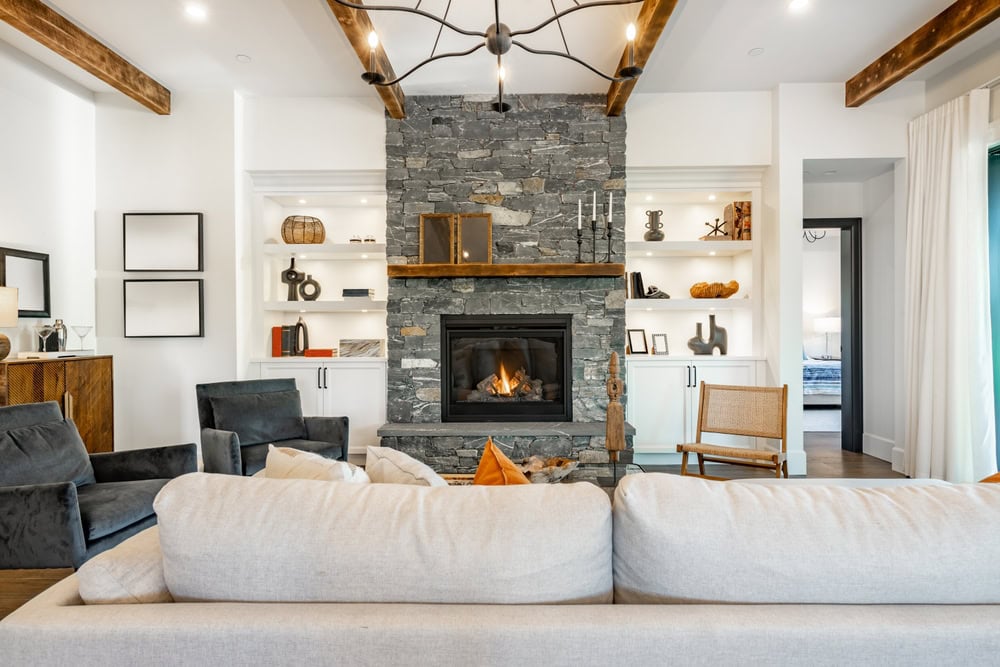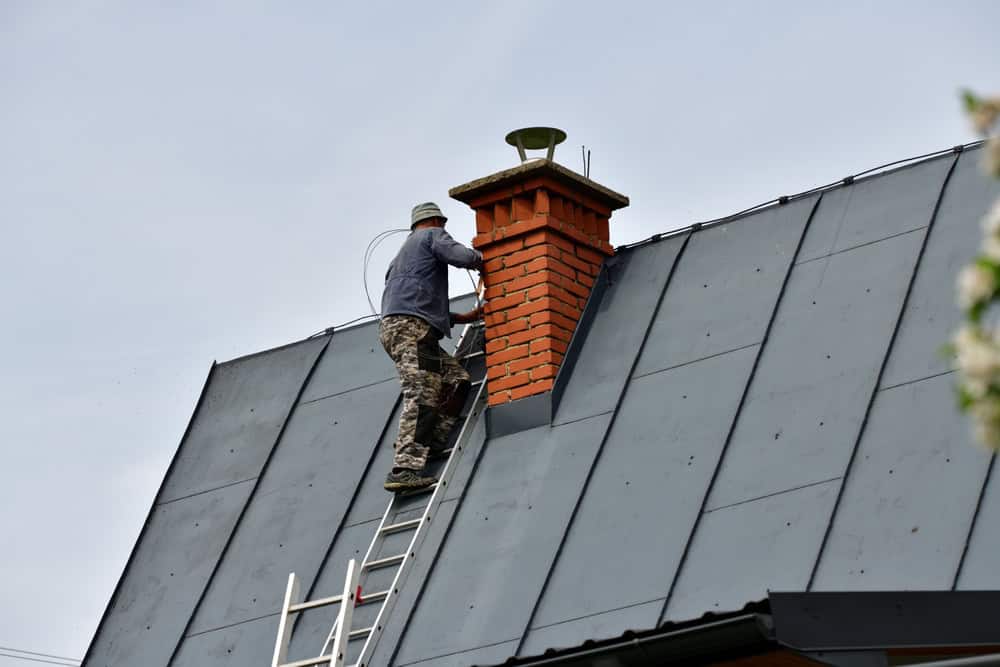
Summary:
Stainless steel liners dominate the Rhode Island market for good reasons. They handle our coastal environment better than most alternatives, resist the acidic moisture that eats through unprotected masonry, and work with all fuel types whether you’re burning wood, running gas, or using oil.
The key is understanding that not all stainless steel is created equal. You’ll encounter 304-grade stainless steel, which works well for most wood-burning applications, and 316-grade stainless steel, which offers superior corrosion resistance for our challenging coastal conditions. We recommend 316-grade for the extra protection against salt air and acidic condensation.
Installation typically runs between $2,500 and $4,000 for most homes, depending on your chimney’s height and condition. The flexible versions navigate bends in older chimneys easily, while rigid versions work best for straight runs.

Rhode Island’s unique climate creates specific challenges that stainless steel liners handle well. The constant moisture from our coastal location, combined with temperature swings that can go from freezing to 40 degrees in a single day, puts serious stress on chimney systems.
Stainless steel liners resist the corrosion caused by this moisture while handling temperature extremes without cracking. Unlike clay tiles that crack when there’s a 500-degree temperature differential, quality stainless steel maintains its integrity through rapid heating and cooling cycles.
The coastal salt air that destroys other materials actually has minimal impact on properly installed 316-grade stainless steel. This is why you’ll see 15-20 year lifespans with proper maintenance, even in waterfront properties where other materials fail much sooner.
However, stainless steel does have limitations. The installation requires proper insulation to prevent heat transfer to surrounding combustibles. Without this insulation, you risk creating dangerous conditions where nearby wood framing could ignite. Professional installation also ensures proper sizing – a liner that’s too large won’t draft properly, while one that’s too small creates dangerous pressure buildup.
The expansion and contraction that comes with our temperature swings can stress connection points if the installation isn’t done correctly. This is why proper professional installation matters more than the material choice itself.
Most Rhode Island homeowners can expect to invest between $2,500 and $4,000 for a complete stainless steel liner installation. This includes the liner itself, insulation, connection hardware, and professional installation. The final cost depends on several factors specific to our area.
Chimney height plays a major role – those tall Victorian chimneys common in Providence and Newport cost more due to additional materials and labor time. Accessibility matters too. If your roof is steep or your chimney location makes it difficult to work safely, expect additional charges.
The condition of your existing chimney affects pricing significantly. If we need to remove an old, damaged liner or make repairs before installation, that adds both time and cost. Many Rhode Island homes built before 1940 have no liner at all, while homes from the 1940s onward typically have deteriorating clay tiles that need removal.
Installation typically takes 4-8 hours for straightforward jobs, with most completed in a single day. Complex installations on tall chimneys or those requiring structural repairs might extend to two days. Weather rarely delays the work since most of the installation happens inside the chimney structure.
The permit process in Rhode Island typically adds $35-45 to your total cost, but we handle this paperwork as part of our service. Some towns require inspections during or after installation to ensure code compliance.
We offer financing options for larger projects, recognizing that a quality liner installation represents a significant but necessary investment in your home’s safety and efficiency.
Want live answers?
Connect with a Certified Chimney Inspections expert for fast, friendly support.
Cast-in-place liners represent the premium end of chimney lining solutions, and for good reason. These systems involve pouring a lightweight, cement-like mixture around an inflatable form inside your chimney, creating a seamless, custom-fitted liner that strengthens your entire chimney structure.
The process creates a smooth, insulated passageway that’s perfectly sized for your specific heating appliance. Unlike stainless steel, there are no joints or seams where gases could potentially leak. The material actually seeps into small cracks and holes in your existing chimney, reinforcing the structure as it cures.
Hybrid systems combine the best of both approaches – typically using cast-in-place material in the smoke chamber area where connections are critical, then transitioning to insulated stainless steel for the main flue run. This approach solves the connection challenges that can plague stainless-steel-only installations while controlling costs.

Cast-in-place liners handle Rhode Island’s challenging climate better than any other option, but they come with trade-offs you need to understand. The seamless construction eliminates the weak points where moisture can penetrate and cause problems.
These systems resist our freeze-thaw cycles exceptionally well because they’re essentially creating a new chimney inside your old one. The insulative properties help maintain consistent temperatures, reducing the thermal stress that destroys other liner types over time.
The material composition handles acidic flue gases without deterioration, making it suitable for any fuel type. Unlike stainless steel, which can suffer stress cracking from thermal cycling, cast-in-place liners expand and contract as a single unit.
Installation requires specialized equipment and expertise, which limits the number of contractors who offer this service. The process involves inserting an inflatable rubber former, then pouring the refractory mixture around it. Once cured overnight, the former is deflated and removed, leaving your custom liner in place.
The main drawback is cost – cast-in-place installations typically run 50-75% more than comparable stainless steel systems. However, the lifespan often exceeds 50 years with minimal maintenance, making the long-term cost per year competitive.
Weather can affect installation timing since the curing process requires specific temperature and humidity conditions. We won’t attempt cast-in-place installations during Rhode Island’s coldest months or during periods of high humidity.
Hybrid liner systems offer a middle ground that addresses the specific challenges Rhode Island homeowners face while controlling costs. These systems typically use cast-in-place material where it matters most – in the smoke chamber and connection areas – while using insulated stainless steel for the main chimney run.
This approach solves the biggest weakness of stainless-steel-only systems: the connection between the liner and smoke chamber. Traditional stainless steel connections often fail over time due to different expansion rates between metal and masonry. Cast-in-place material in this critical area creates an airtight seal that lasts.
The stainless steel portion handles the main venting function efficiently while keeping material costs reasonable. You get the durability benefits of cast-in-place where you need it most, with the cost-effectiveness of stainless steel for the bulk of the system.
Installation complexity falls between the two individual systems. We need expertise in both techniques, but the process is more straightforward than full cast-in-place installation. Total costs typically run 20-30% more than stainless-steel-only systems while providing significantly better long-term performance.
The hybrid approach works particularly well for older Rhode Island homes where the existing chimney structure has some deterioration but doesn’t require complete rebuilding. The cast-in-place portion can seal minor issues in the smoke chamber area while the stainless steel handles the main venting function.
Maintenance requirements are minimal – annual inspections to check for any settling or minor issues, but the robust construction typically provides decades of trouble-free operation. This makes hybrid systems attractive for homeowners who plan to stay in their homes long-term.
Your choice between stainless steel, cast-in-place, or hybrid liners comes down to balancing performance, longevity, and budget for your specific situation. Stainless steel offers proven performance at reasonable cost, cast-in-place provides maximum durability for premium investment, and hybrid systems deliver the best of both worlds.
Consider your home’s age, your heating system type, and how long you plan to stay when making this decision. Factor in Rhode Island’s coastal climate and the importance of proper installation by certified professionals who understand our local conditions.
The investment in a quality liner system protects your family’s safety, improves your heating efficiency, and preserves your home’s value. For expert guidance on the best solution for your specific situation, contact us to discuss your needs with experienced professionals who understand Rhode Island homes.